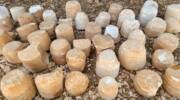
By Rabbi Ari Enkin, Rabbinic Director, United with Israel
Read about the commandment of tzitzit and see just how important it is!
It is in this week’s portion (Shlach – Numbers 13:1-15:41 ), where God gives the mitzva (commandment) of tzitzit – wearing fringes on the corners of our garments.
As the Torah says:
Speak to the children of Israel and tell them to put fringes on the corners of their garments throughout their generations…and they shall put on the corner a blue thread…in order that you remember to perform all the mitzvot (commandments) of God.
Although in ancient days tzitzit were worn on virtually all garments, certainly the outer garments, today this is not the case. This is because the mitzva to put fringes on the corners of a garment only applies to those that have four corners. In our day and age, however, our clothes are not four-cornered. Today we have pants, suits, jackets, shirts, and a variety of other clothes in our wardrobe that do not have four distinct square corners.
Today, tzitzit come in two varieties: the tallit katan (small prayer shawl) and tallit gadol (large prayer shawl). The former is a small four-cornered garment, comparable to an undershirt, but it has fringes at the corners. Observant Jews wear this garment under their clothes. Some people expose the fringes outside of their pants, while others keep the tallit katan completely concealed under their clothes.
The tallit gadol is generally only worn during the morning prayers. It is a large, external garment that must cover the majority of the body. It, too, has four corners with fringes at each one. In some communities, the tallit gadol is only worn after marriage, while in others it is worn from the time of the bar mitzva onwards.
Each tassel, or fringe, is formed out of four strands of wool that are doubled, so that the final fringe appears as eight strings. Before tied, the strings are passed through specially designated holes at the corners of the garment, about an inch away from the end. Five knots are made along the length of the fringe, with the longest string being wound around all the other between each of these knots. After these five knots are made, the remaining length of the string is left to hang freely – sometimes even touching the floor!
Although the Torah mentions the use of a blue string as part of this four-string bundle, nowadays it is not widely used. This is due to the fact that there is some uncertainty among rabbinic scholars as to how the blue dye is to be produced. Based on this and other considerations, it was decided long ago to do away with the blue string entirely rather than possibly produce the wrong color dye. In recent times, however, there are those who claim to have discovered exactly how the blue dye was made.
As such, a number of tzitzit manufactures have begun producing this blue dye and the blue string – using colors derived from a particular snail.
According to the Rambam (Maimonides), the mitzva of tzitzit is on par with the mitzva of circumcision – which surely gives us an idea how important it is! For those Jews who don’t yet have tzitzit – be sure to get yours today!
Do You Love Israel? Make a Donation - Show Your Support!
Donate to vital charities that help protect Israeli citizens and inspire millions around the world to support Israel too!
Now more than ever, Israel needs your help to fight and win the war -- including on the battlefield of public opinion.
Antisemitism, anti-Israel bias and boycotts are out of control. Israel's enemies are inciting terror and violence against innocent Israelis and Jews around the world. Help us fight back!






















